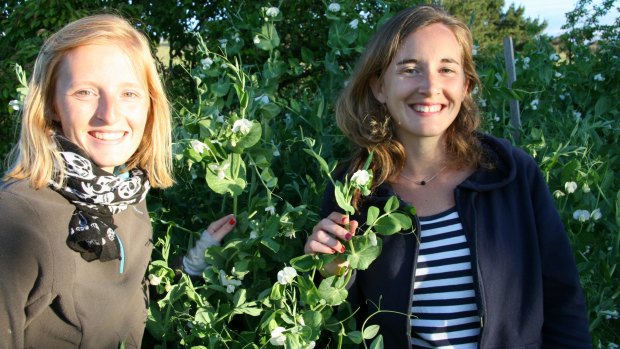This was published 9 years ago
Edible spring flowers for Canberra gardens
They are so colourful at this time of year, so which ones are great for the dinner table? Owen Pidgeon reveals his favourites.
By Owen Pidgeon
The delights of springtime are upon us and in the garden there are few things more delicate for the plate than the tender tips of growing vegetables and the flowers themselves.
Snow peas are now coming in abundance, from the late autumn plantings. In the early morning, you can trim off the little tendrils with the first few delicate leaves to use in your salads. Select some of the beautiful white snow pea flowers to decorate as well. The only decision to be made is what proportion of your springtime abundance do you harvest this morning and how much do you allow the flowers to stay and the tendrils to run further for future production of tender snow peas.

Salad suggestion: Marion Prouvost, of Lille, and Hortense Clavreul, of Compiegne, France, harvest snow peas.
If you have some space, plant two or three extra rows of snow peas now to get a late crop before the hottest summer days. Snow peas are a great addition to any garden and to many dishes prepared in your kitchen.
Broad beans also produce delicate small white and black flowers which are very edible and they do carry the taste of the bean itself. You might have to sacrifice a 15-20 cm length of stem to secure sufficient flowers for your guests. Try planting a spring crop of broad beans now, with the aim of gathering a harvest of flowers and tender beans just after Christmas.
Rocket, or Italian cress, is one of those great fast-growing plants for the home garden. It can be left to grow beyond its first flush of tender, edible leaves to produce long stems with very small flowers adorning the length of the stem. Pick the stems and use the flowers then cut the plants back heavily to promote the growth of new tender shoots.
Rocket takes just 3 to 4 weeks to produce a good crop after planting, so you can enjoy this peppery green salad vegetable throughout the summer, by regular succession planting of a few seeds. Plant the seeds very shallow and keep the soil moist and they will appear within days.
Nasturtium flowers and the young tender leaves of the plant are also a great addition to your mixed salads, with their peppery taste. The beautiful colours of the flowers will remind you of an artist's palette. Nasturtiums are very hardy plants and prefer to grow in well drained but poorer quality soil, to produce a crop of flowers. To aim for a crop of mid summer flowers, seeds need to be planted in early spring, so try to plant in the next few days. You can also take cuttings of the perennial nasturtium plants now from the new growth.
Borage is the other fast growing Mediterranean plant that produces dainty blue flowers after 5-6 weeks, adding colour to salads. It is a hardy annual with spreading stems. As with nasturtiums, do not plant the seeds into rich soil as they grow best in well drained, rather poor soils. Sow seeds 5mm deep directly into the garden bed. They do not like to be transplanted, as they grow deep taproots. The young leaves are quite hairy but flavoursome, with a taste similar to cucumber.
This week in the garden:
Plant rows of lettuces, rocket, mizuna and tatsoi for summer salads.
Plant out tomatoes, capsicums and eggplant seedlings over the next two weeks. Dig in plenty of compost and manures. Ensure that you have fresh ground, not where you grew these plants or potatoes last summer. Cover overnight if the temperatures fall.
Plant out pumpkin and zucchini seedlings into round circle beds which have been filled with deep layers of compost and aged manures.
Mulch all new garden beds with a generous amount of lucerne hay, sugar cane or pea straw mulch.
Water small seedlings each morning and evening to prevent them dying from lack of moisture.
Take a look at your fruit trees and remove excess small fruit where the branches are heavily laden, especially pear and apple trees.
Owen Pidgeon runs the Loriendale Organic Orchard near Hall.